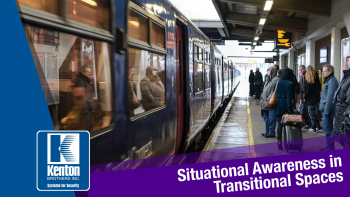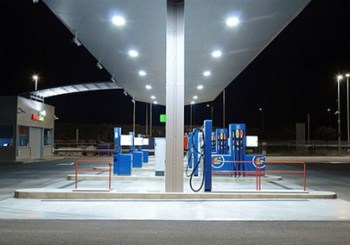The Crucial Role of Situational Awareness in Transitional Spaces for Personal Safety and Security
By David Strickland, Vice President of Kenton Brothers
 At Kenton Brothers Systems for Security, our mission is to protect people property and possessions. It’s important work, and we take our work very seriously. A part of our role is creating policy and procedures for companies around physical security and how you interact with the situational environment around you. For instance, if there is an active shooter scenario at your workplace, we would help your company create the procedure for helping those affected deal with that situation. Today we are taking a different spin.
At Kenton Brothers Systems for Security, our mission is to protect people property and possessions. It’s important work, and we take our work very seriously. A part of our role is creating policy and procedures for companies around physical security and how you interact with the situational environment around you. For instance, if there is an active shooter scenario at your workplace, we would help your company create the procedure for helping those affected deal with that situation. Today we are taking a different spin.
We live in a distracted world full of cell phone screens. In these distracted times of modern life, we often find ourselves moving through transitional spaces without giving them a second thought. Whether it’s walking through a parking lot, riding public transportation, or simply strolling down a city street, these transitional spaces are an integral part of our daily routines.
It’s precisely in these seemingly mundane environments that the importance of situational awareness becomes most apparent. In this blog, we’ll explore why situational awareness is paramount for personal safety and security in transitional spaces, shedding light on the potential threats that lurk in the shadows and the common distractions that hinder our ability to stay vigilant.
Understanding Situational Awareness
 Situational awareness, often described as the perception of environmental elements and events with respect to time or space, plays a pivotal role in personal safety and security. In transitional spaces, being attuned to your surroundings means being able to identify potential threats, assess the level of risk, and respond appropriately to ensure your well-being.
Situational awareness, often described as the perception of environmental elements and events with respect to time or space, plays a pivotal role in personal safety and security. In transitional spaces, being attuned to your surroundings means being able to identify potential threats, assess the level of risk, and respond appropriately to ensure your well-being.
Transitional spaces are unique in that they serve as connectors between different environments. They are the thresholds between safety and potential danger, requiring individuals to adapt their awareness to the changing dynamics of the space. Whether you’re stepping out of your car into a dimly lit parking garage or navigating a crowded subway station, situational awareness acts as a shield against unexpected threats.
Common Distractions in Transitional Spaces
To truly grasp the significance of situational awareness, it’s essential to recognize the myriad distractions that can divert our attention, leaving us vulnerable to potential risks. Here are some common distractions that people often encounter in transitional spaces:
Technological Distractions: The ubiquity of smartphones has created a generation of individuals constantly engrossed in their screens. Whether texting, browsing social media, or listening to music, these technological distractions can significantly reduce awareness of one’s surroundings.
Daydreaming: Mental preoccupation with thoughts unrelated to the immediate environment is another common distraction. Whether worrying about work, personal matters, or daydreaming, being mentally elsewhere can prevent individuals from recognizing potential threats.
Noise Pollution: Overstimulation from loud noises, whether it be traffic, construction, or public announcements, can overwhelm the senses and make it challenging to focus on important auditory cues.
Complacency: Familiarity with a particular transitional space can breed complacency. Individuals may assume that because they have traversed a route countless times without incident, there is no need for heightened awareness. This false sense of security can be dangerous.
So what’s the big deal?
The Implications of Inattention
Crimes of convenience are rising at alarming rate. Failing to maintain situational awareness in transitional spaces can have severe consequences. Criminals often exploit these environments due to the perceived lack of vigilance from potential victims. From pickpocketing to more serious crimes, individuals who are not fully aware of their surroundings become easy targets.
Moreover, emergencies such as fires, natural disasters, or medical incidents can occur at any time. Without situational awareness, individuals may struggle to respond effectively to these situations, putting their safety and the safety of others at risk. Do you know where the exit is? How about the closest storm shelter? You should.
So, what can I do specifically?
Enhancing Situational Awareness
Now that we understand the importance of situational awareness, let’s explore strategies to enhance this critical skill in transitional spaces:
Limit Technological Distractions: While smartphones are valuable tools, it’s crucial to use them judiciously in transitional spaces. Consider keeping your phone in your pocket and headphones off until you’ve safely navigated the area.
Practice Mindfulness: Actively engage with your surroundings by practicing mindfulness. Take note of the people, sounds, and potential exit points in a given space. This heightened awareness can significantly improve your ability to respond to potential threats.
Vary Your Routes: Avoid falling into a routine that breeds complacency. Deliberately choose different routes when possible to keep your awareness sharp and adaptable to changing environments.
Trust Your Instincts: Intuition often serves as a powerful guide in assessing potential threats. Read that again. If something feels off or uncomfortable, trust your instincts and take appropriate action, whether it’s changing your route or seeking assistance.
In the complex dance of daily life, transitional spaces demand our utmost attention and vigilance. Situational awareness isn’t just a skill; it’s a mindset that can be cultivated and honed through conscious effort and practice. By acknowledging the potential threats in transitional spaces and understanding the distractions that impede our awareness, we empower ourselves to navigate these environments with confidence and security.
It’s not your imagination, the world we live in is more dangerous. Situational awareness stands as a beacon, guiding us through the labyrinth of transitional spaces. It’s a skill that transcends the physical, extending into the realms of mental preparedness and proactive engagement with our surroundings. So, the next time you find yourself in a transitional space, remember: stay vigilant, stay aware, and stay safe.
Thank you for reading this blog Kenton Brothers Systems for security is celebrating its 126th year in business. We blog every week and would love to have you subscribe to our newsletter!




Leave a Reply
Want to join the discussion?Feel free to contribute!